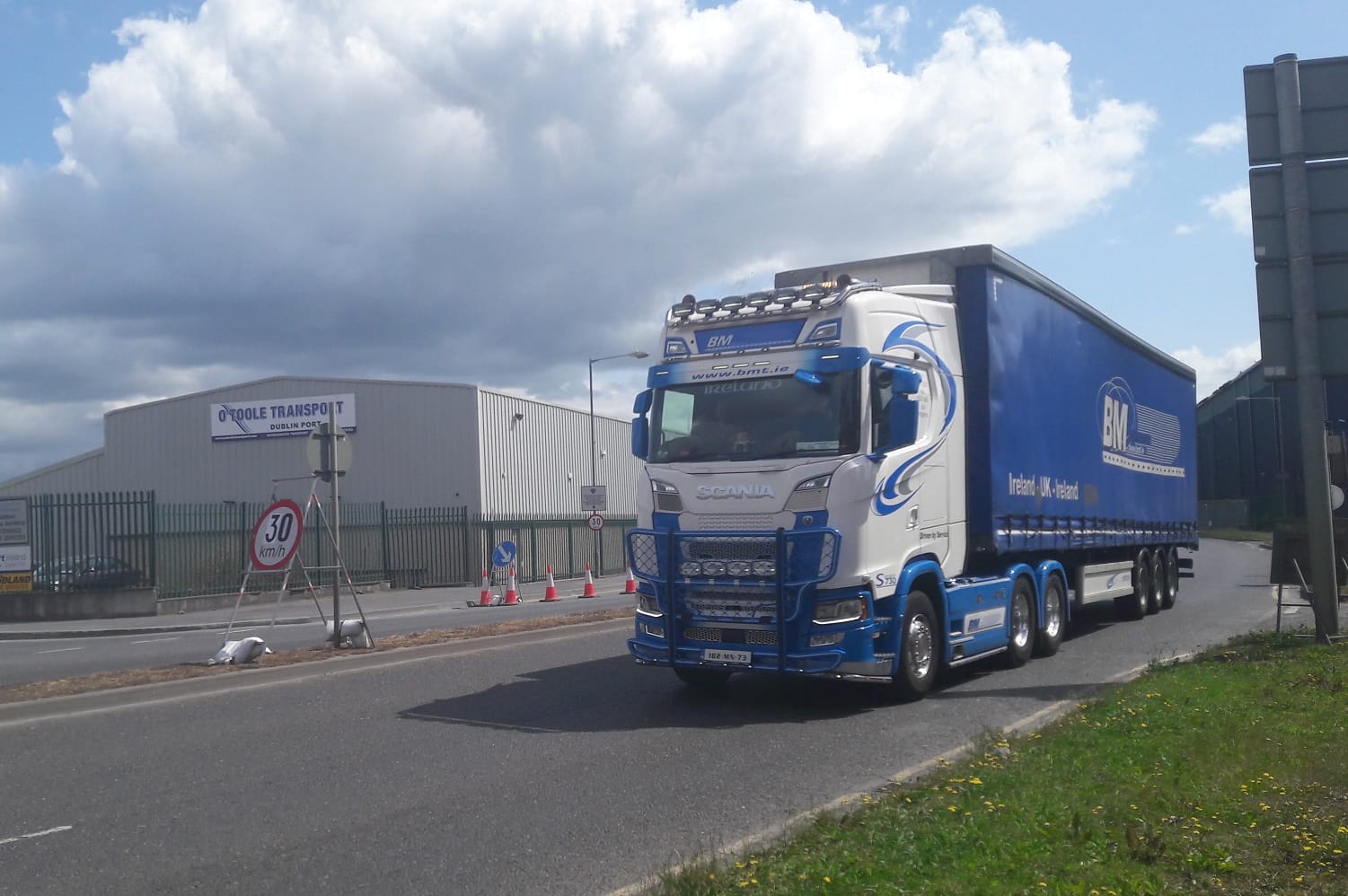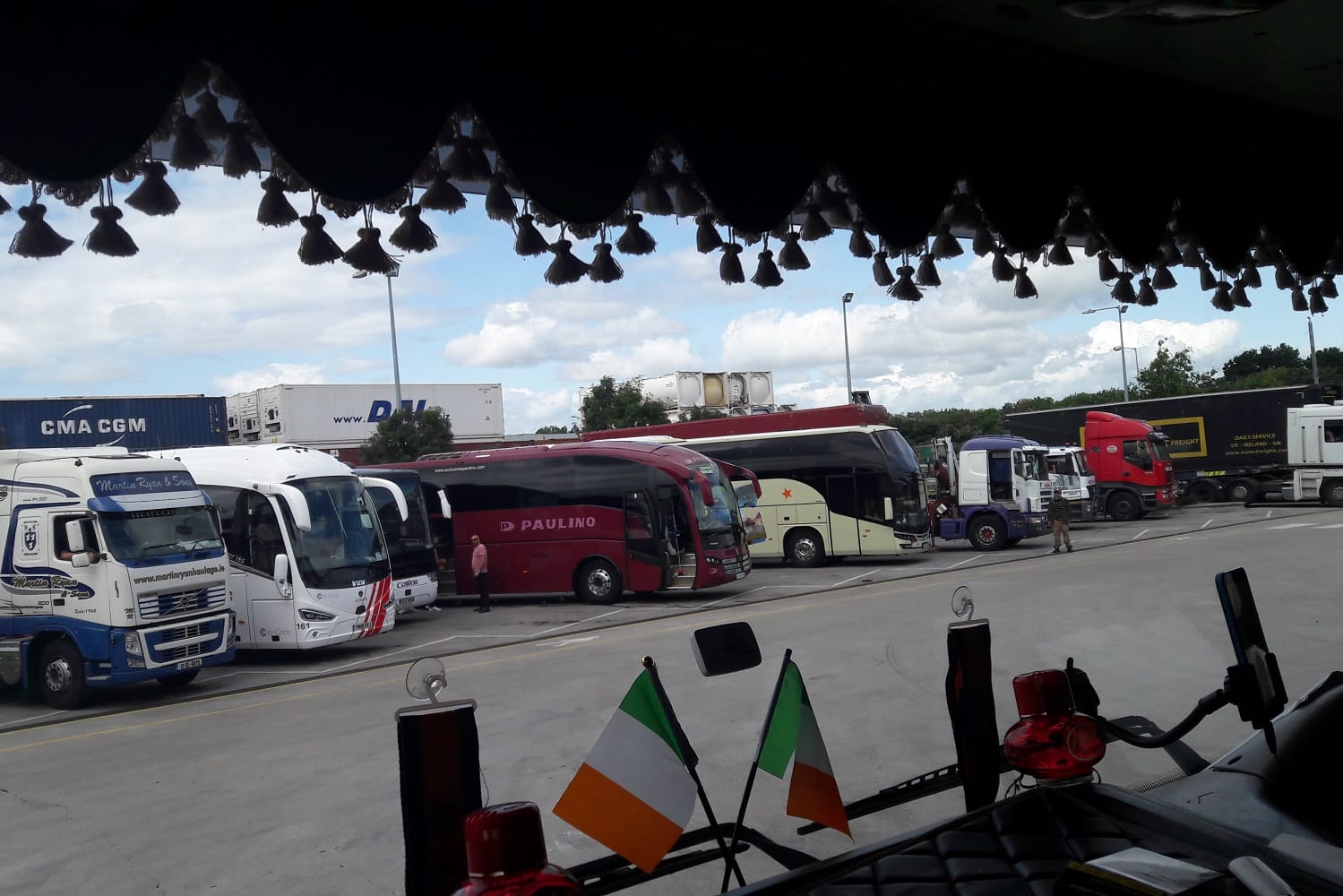What’s the best way to tell area residents about plans for a new asylum shelter nearby?
The government should tell communities directly about plans for new asylum shelters, some activists and politicians say.
At least once a week for 20 years, Francis Dempsey has photographed trucks and drivers as they roll into Dublin Port. He’s worried about their future.

Francis Dempsey stands on a traffic island on the East Wall Road, next to Point Square Dublin.
Cars, buses, lorries and 18-wheeler trucks rumble past at speed. It’s just after 11am, a Thursday morning – and it’s loud, windy and intimidating.
Dempsey, though, is smiling.
He holds his Kodak PIXPRO camera with both hands, the strap hanging down. As the vehicles draw in and out of the port entrance on Alexandra Road, Dempsey casually lifts the camera a little and snaps a picture.
“I’ve been doing this 24 years,” he says. He reckons he has thousands and thousands of images, saved on two computers at his home in Celbridge, County Kildare.
Dempsey enjoys making connections with drivers and providing “good PR” for Dublin Port, he says. “Only for the guys, I would be lost.”
He’s worried for them these days, though. He fears what Brexit will mean for the Irish haulage industry, for the drivers he greets and photographs week in, week out.
“Things are going to get a lot tougher,” Dempsey says.
There could be undercutting for contracts, he thinks, if companies leave the UK and enter Ireland. What if Irish Ferries pull out of Holyhead?
Dempsey circles back to Brexit, again and again. “People don’t think it will happen, but it will,” he says.

Most, if not all, the drivers that go by seem to recognise Dempsey. They honk, wave or nod. Some flash their trucks’ LED lights – just for the photo.
Dempsey goes down to the port once or twice a week to photograph the trucks. Scanias are his favourite, he says. “Volvo, not really.”
He likes that “you never know what will turn up”. Around the corner could be a massive tank for Guinness. Or a new coach bus.
He posts his cache almost daily on two Facebook pages. His newer one, truckingireland.com has more than 5,200 likes.
He’s proud of the numbers: “I have the Irish Haulage Association and the British Haulage Association following me!”
He posts on his personal account too, where truck drivers and car enthusiasts – their devotion clear from profile and cover photos – tag each other and comment.
“Truckers are proud of their trucks,” he says. “And they like looking at themselves on the internet. If this truck is dirty, you see all the slagging that goes on.”
“Drivers like trucks and they like to see themselves,” says Frank Dillon, inside the port, later. He’s winding up for the day, about to head home.
He’s got a “whole lot” of pride in his truck, he says. He works for Curley’s Quality Food in Galway and drives a Scania R500.
“I’ve actually never seen myself on your page,” he says to Dempsey, playfully nudging him.
Inside the port, there’s a Circle K filling station where drivers fill their tanks with diesel or stop for a bite to eat.
Dempsey can’t photograph inside. Security won’t allow it, he says.
“It’s my future, my life. It’s everything,” says Joe Rame, of the truck he’s just finished filling, a white Volvo FH12.
After more than 40 years, the job is “handy enough”, Rame says. On Thursday he’ll be off to England, delivering compostable mushrooms for a company called Walsh’s.
Some stay closer to home, these days. Martin Ward mostly drives around Dublin but sometimes goes to Cork and Limerick, too.
“It’s [a driver’s] home, basically,” says Ward, of his truck. He’s been 35 years on the job.
“Even though it’s not mine, but it’s mine. You know?” he says. “I’m the only one on it, whereas other family [businesses] have four or five drivers on the one truck.”

Ward makes it personal, with a radio, classic red tasselled curtains, comfortable seat covers and two tricolours. “Keeping it Irish,” he says, with a laugh.
He’s changed the flooring and has added big, heavy duvet, to keep him warm at night.
Trucks have gotten better over the years, he says. They’re automatic now, not stick-shift like years ago.
“I wouldn’t call myself an enthusiast, but I like me comfort,” he says. “It’s like a woman and a new home.”
Trucking can be lonely, though. “[Driving] doesn’t do it for me that much anymore,” says Mike Carroll, who’s been driving trucks for 28 years. He owns an events company now, too.
“A lot of drivers are isolated,” he says. “You’re spending 60–70 hours a week on the road.”
Once he’s done taking photos at the port, Dempsey will travel to Blanchardstown to take photos for Eirebus of their recently painted buses.
It’s not paid, though. He doesn’t charge. “It’s just a hobby,” he says. “People like the quality of the photos. They’re good photos.”
Dempsey used to work for a security company based in Dublin Port. “I have respect for [drivers], they work very, very long hours,” he says.
“They’re away from their families … there are young women in this industry now – 21, 22 [years old]. The young girls can still give it to the men,” he says, laughing. “I have full respect for them, they’re proud of their trucks as well.”
“It’s these guys that keep the country going,” he says of the exporting and importing trade.
“If these guys walked out, there would be a revolution in this country. There would be no bread, milk, [medicine], etcetera.”
“I can see a lot of guys getting out maybe before Brexit,” Dempsey says. “It’s a low-pay industry.”
With Brexit, Dempsey says that some drivers are concerned that companies that pull out of the UK will enter the Irish market.
A driver of a Scania truck throws his thumbs up to Dempsey, who bellows out, “How are ya? Are ya well?”
Dempsey has a bruise over his right eye. He was punched while he was taking photos earlier in the week, he says.
“Did you take a photo of him? Did you do something that might have provoked him?” asks Dillon.
Dempsey says he was minding his own business. “He just wanted to have a go,” he says.
He’d posted about the assault online. Drivers posted dozens of comments of support. “They look out for me, and I look out for them,” he says.
At just before 1pm, Dempsey heads off. He’s two buses to catch to get out to Blanchardstown, to Eirebus.
After that, he’ll drop into Connolly Hospital to visit his father, he says.
It’s been a few years since Dempsey worked, he says. Family matters have taken up his time. He lost his mother to cancer last year.
“It’s only for the guys here. They tell me when I die, there’ll be a statue of me on East Wall Road!” he says, laughing. “I’ll always haunt them.”